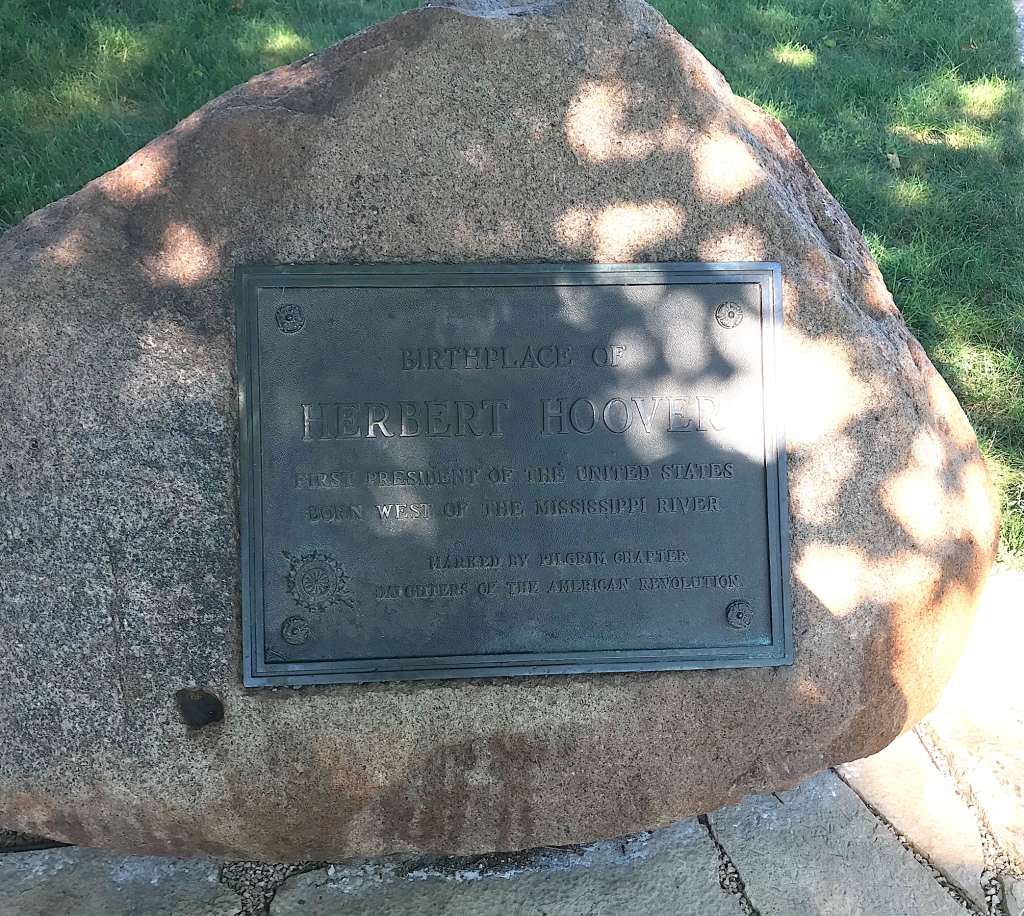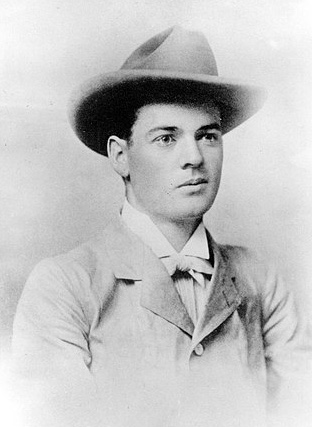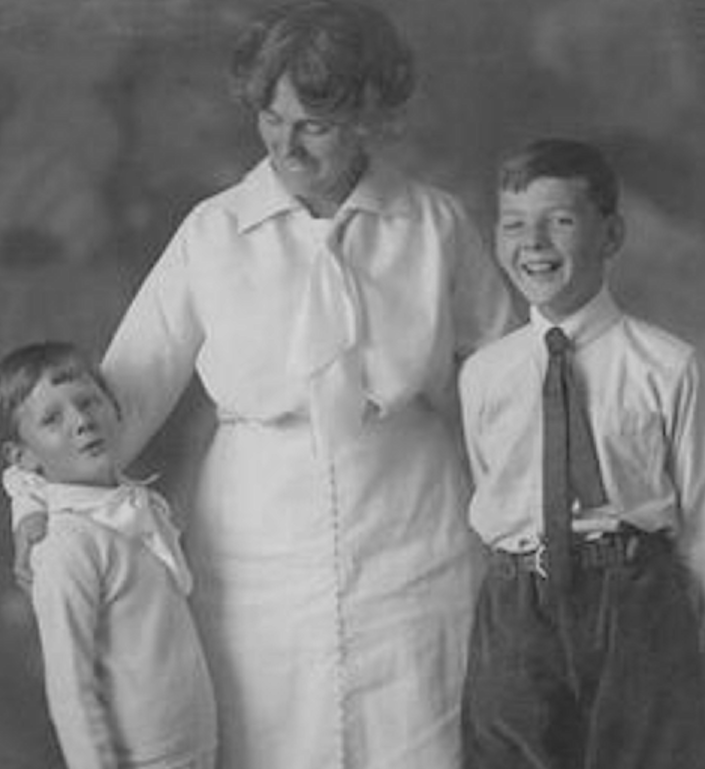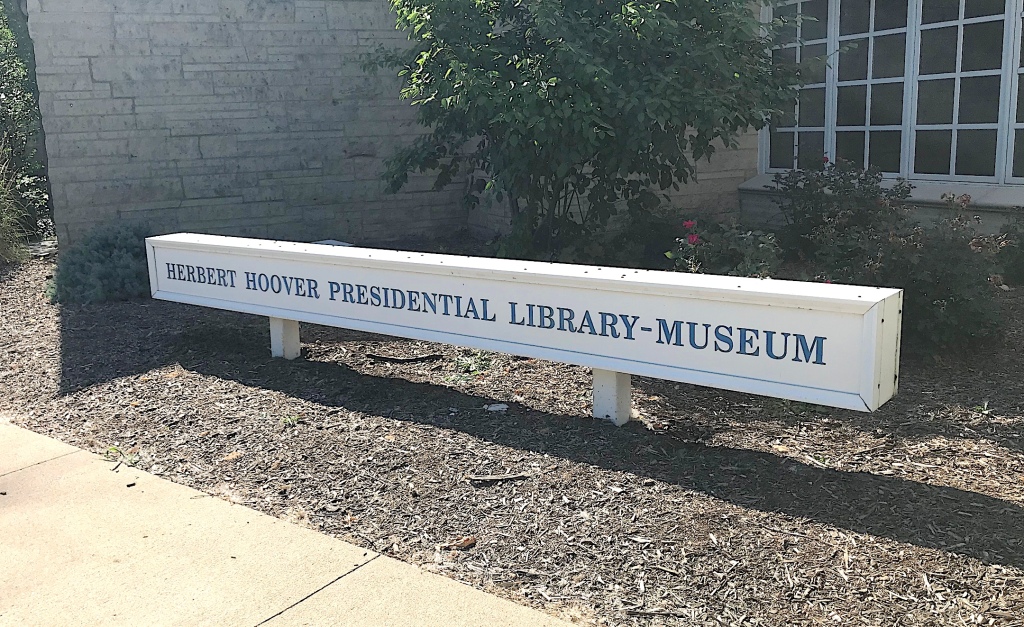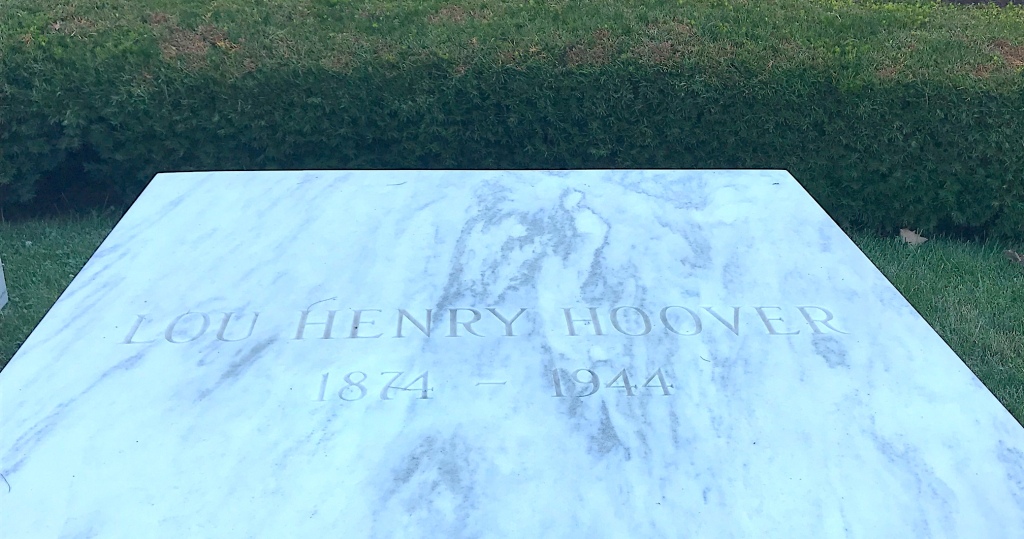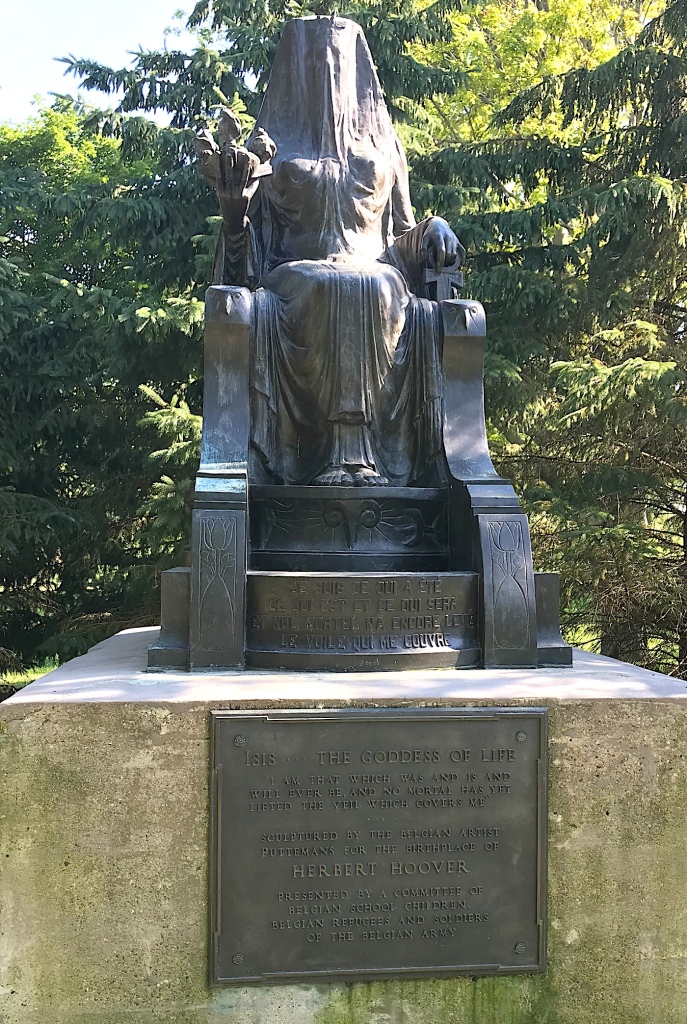When I realized we would be driving right past the Herbert Hoover Presidential Library in West Branch, Iowa on our journey back to Omaha, I was determine that we’d stop. We wouldn’t have time to visit the library itself, but if it was possible to get a glimpse of Hoover’s grave, I was going to try.
This was my first official U.S. presidential grave! I’ve seen 10 more since, but seeing Hoover’s was special to me.
Born in West Branch, Iowa
Herbert Clark Hoover was born in West Branch, Iowa on Aug. 10, 1874, making him the first American president to be born west of the Mississippi River.
His father, Jesse Hoover, was a blacksmith and farm implement store owner. His mother, Hulda Randall Minthorn Hoover, raised in Canada, moved to Iowa in 1859. They were Quakers. From what I’ve read, he had a happy early childhood.
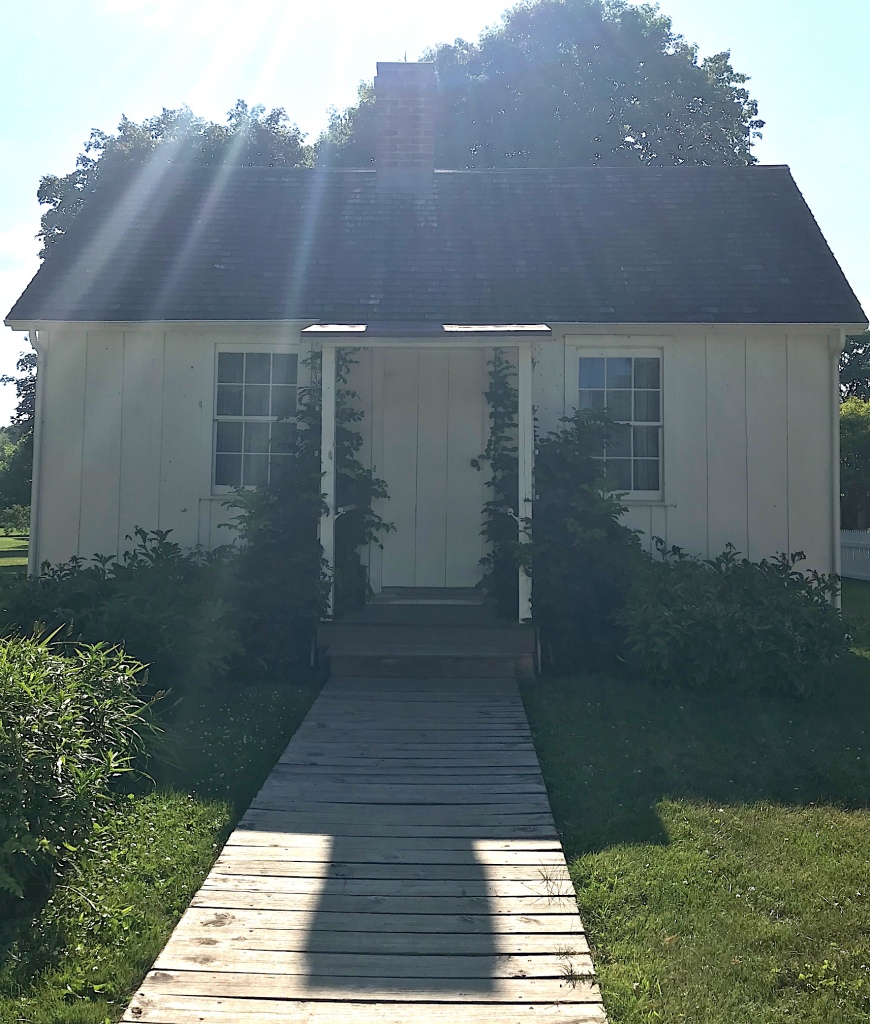
Jesse died in 1880 at age 34 of a sudden heart attack and Hulda died in 1884 of typhoid, leaving Herbert and his two siblings orphans. Hoover lived the next 18 months with his paternal uncle Allen Hoover at a nearby farm.
In November 1885, Hoover went to Newberg, Ore., to live with his maternal uncle John Minthorn, a Quaker physician and businessman. The Minthorn household was considered cultured and educational, and imparted in Herbert a strong work ethic.
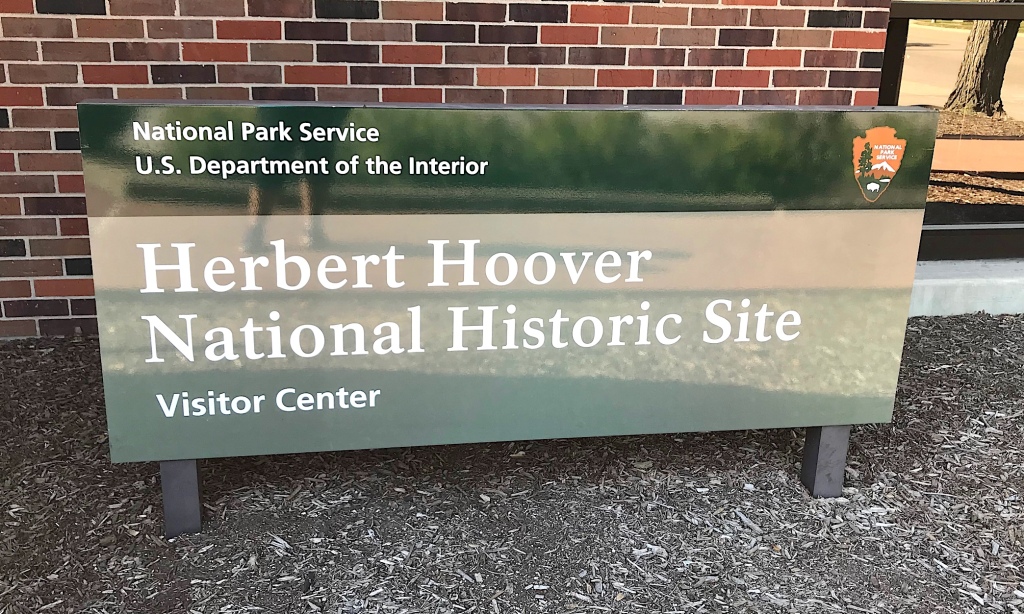
We did watch a film at the visitor’s center before they closed. I was curious to know why, since Hoover only lived in West Branch nine years, did he choose it as the site for his presidential library? Apparently, Hoover always had fond memories of his childhood in West Branch, when his parents were still living, so that’s where he wanted it.
The library and museum are located within the Herbert Hoover National Historic Site, which contains Hoover’s birthplace, a reconstruction of Hoover’s father’s blacksmith shop, a one-room schoolhouse, and a Quaker meeting house. We had time to briefly visit Hoover’s birthplace cottage then hoofed it down a long path up a hillside to his grave. The National Park Service manages the site.
Early Days
Plenty of authors have written about the Hoovers, so I’m going to try to hit the highlights.
Herbert Hoover was part of the inaugural class at Stanford University in Palo Alto, Calif. He graduated in 1895 with a degree in geology and became a mining engineer, working on a wide variety of projects on four continents.
While a senior at Stanford, Hoover met his future wife, Waterloo, Iowa native Lou Henry. Born in 1874, Lou grew up something of a tomboy in the Monterey, Calif. area. She loved the outdoors as much as Herbert did.
Lou got a teaching credential in 1893 from San Jose State University (then San Jose Normal School) and worked at her father’s bank. The following year, she enrolled at Stanford to pursue a degree in geology. In 1898, Lou became the first woman to receive a bachelor’s degree in geology from Stanford, one of the first women in America to hold such a degree.
Married Life
In 1897, Hoover took an engineering job in Australia. Lou and Herbert were engaged before he left. They were married in her family’s home on Feb. 10, 1899. Herbert was hired as chief engineer of the Chinese Engineering and Mining Company in Tianjin, China, where they went after their honeymoon.
Caught in China during the Boxer Rebellion in 1900, Hoover organized relief for trapped foreigners. Lou, who learned Chinese, treated gunshot wounds, built barricades, and rode through the area on her bicycle with a pistol patrolling with Western troops. I have to say, Lou was no slouch!
The Hoovers made their home in London in November 1901 after Herbert was offered a partnership with a British mining company. His work took them all over the world. The Hoovers had two sons who joined them as they traveled. Herbert Hoover Jr. was born in 1903, and Allan Hoover was born in 1907. The family became wealthy after Herbert’s decision to become an independent consultant in 1908.
In 1914, Hoover helped Americans stranded in Europe at the outbreak of World War I. For the next three years, he headed the Commission for Relief in Belgium, helping find food for some nine million people. His skills impressed Pres. Woodrow Wilson so much that he appointed him U.S. food administrator for the duration of the war.
The Hoovers returned to America in January 1917. When the U.S. entered World War I three months later, Herbert was appointed head of the Food and Drug Administration, and the family made their home in Washington, D.C.
After World War I
Hoover was tapped to head the American Relief Administration. The ARA sent food and supplies to war-ravaged Europe. The outreach to Soviet Russia garnered Hoover much criticism, but he defended his actions by saying, “Twenty million people are starving. Whatever their politics, they shall be fed.”
In 1921, President-elect Warren G. Harding chose Hoover to serve as secretary of commerce. Continuing as commerce secretary under Pres. Calvin Coolidge, Hoover spearheaded efforts that ultimately led to construction of Hoover Dam and the St. Lawrence Seaway.
When Coolidge decided not to run for another term in 1928, Hoover received the Republican presidential nomination. Hoover and running mate Charles Curtis ran against New York Gov. Alfred E. Smith and vice presidential candidate Joseph T. Robinson in a contest that focused on Prohibition and religion. Hoover captured more than 21 million popular votes to Smith’s approximately 15 million, and he received 444 electoral votes to his Democratic opponent’s 87.
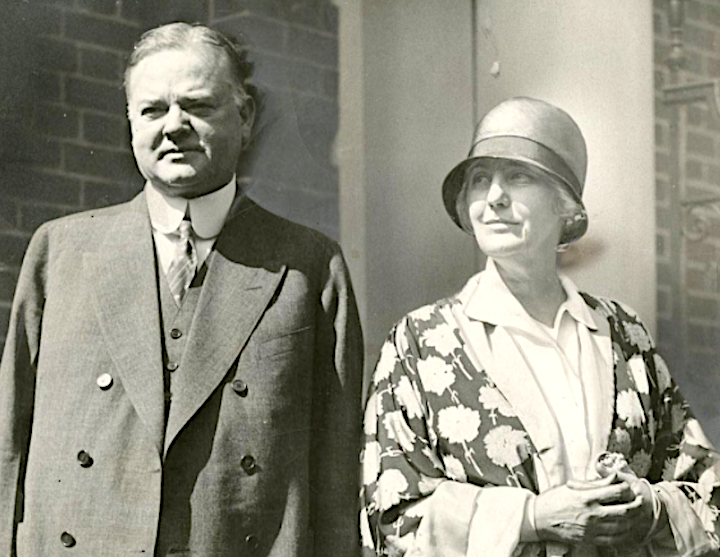
Presidential Years
Lou was her husband’s frequent adviser while he was president. Throughout her tenure, she refused to give interviews to the press, seeing them as intrusive. Instead, she gave speeches over the radio, the first president’s wife to do so.
The stock market cash of 1929 plunged the country into the worst economic collapse in its history. Hoover parted ways with leaders of the Republican Party who thought there was nothing for the government to do but wait for the next phase of the business cycle.

Hoover called business leaders to the White House to urge them not to lay off workers or cut wages. He urged state and local governments to join private charities in caring for Americans made destitute by the Depression. He asked Congress to appropriate money for public works projects to expand government employment. He established new agencies such as the Federal Farm Board, the Federal Drought Relief Committee, and the Reconstruction Finance Corporation.
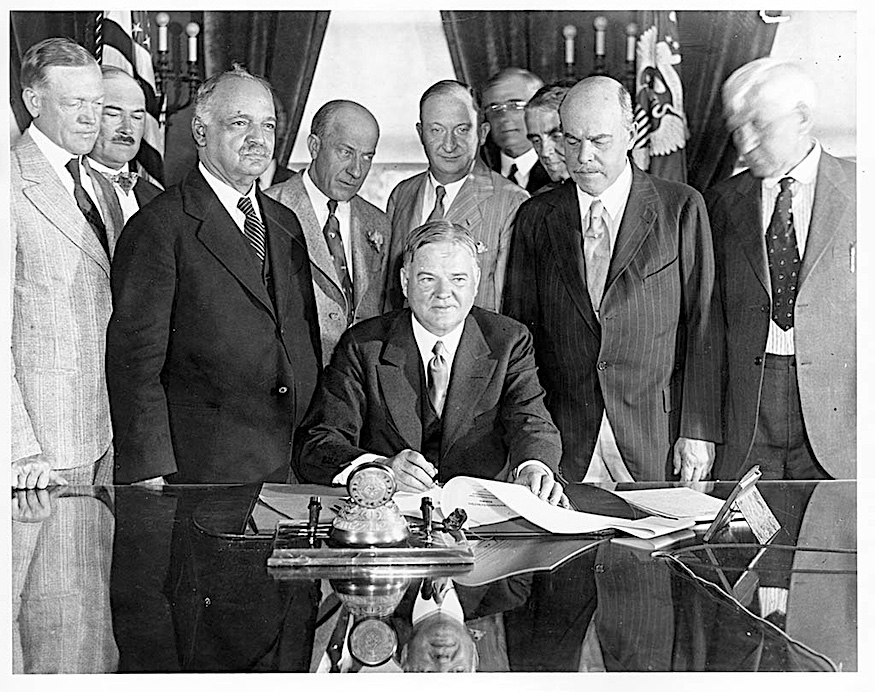
But Hoover would not provide direct federal relief to the unemployed. Instead, he promoted indirect relief through public works projects and loans to states. His programs proved inadequate as the number of unemployed workers increased from 7 million in 1931 to 11 million in 1933.
Hoover’s political reputation as the “master of emergencies” collapsed in the face of rising unemployment. Although he mounted a vigorous campaign for re-election in 1932, Hoover lost to Franklin D. Roosevelt. The Hoovers departed Washington on March 4, 1933. He was only 58.
Back to Private Life
While Hoover considered going back into politics after his defeat, the Hoovers were understandably bitter about what happened. He and Lou lived in Palo Alto until her death after a heart attack in New York City at the Waldorf Astoria Hotel on Jan. 7, 1944. Her funeral was held at St. Bartholomew’s Church in New York.

Hoover was a constant critic of Roosevelt. In response to continued attacks on his character and presidency, Hoover wrote more than two dozen books, including The Challenge to Liberty (1934). At the 1940 Republican National Convention, Hoover hoped for the presidential nomination, but it went to the Wendell Willkie, who lost to Roosevelt in the general election.
After World War II, Hoover befriended President Harry Truman despite their differences. Because of Hoover’s experience with Germany at the end of World War I, Truman selected him in 1946 to tour Allied-occupied Germany and Rome, Italy to ascertain the food needs of the occupied nations. On Hoover’s initiative, a school meals program in the American and British occupation zones of Germany began on April 14, 1947. It served 3,500,000 children.
In 1954, a group of Hoover’s friends incorporated the Herbert Hoover Birthplace Foundation to raise money for preservation of his birthplace, and to plan for site improvements. One of their ideas was to build a small museum, and with Hoover’s approval work began in the late 1950s. The architectural firm of Eggers and Higgins of New York drew the plans for the original building. While the museum at West Branch was still under construction, Hoover decided to expand it and make it his Presidential Library.
The Library and Museum was officially dedicated on Aug. 10, 1962, Hoover’s 88th birthday. Hoover and former President Truman were present at the dedication.

Herbert Hoover died in New York City on Oct. 20, 1964, following massive internal bleeding. Two months earlier, Hoover reached the age of 90, only the second U.S. president (after John Adams) to do so. At the time of his death, Hoover had been out of office for over 31 years. This was the longest retirement in presidential history until Jimmy Carter broke that record in September 2012. Hoover was honored with a state funeral in which he lay in state in the U.S. Capitol rotunda.

On October 25, Hoover was buried in West Branch. Lou Hoover, buried in Palo Alto following her death in 1944, was re-interred beside him soon after.
The original Library and Museum building was expanded several times. On Aug. 8, 1992, former President Ronald Reagan rededicated the Library and Museum. The $6.5 million renovation/expansion was a public–private partnership, with Washington supplying $5 million for bricks and mortar, supplementing $1.5 million raised by the Herbert Hoover Presidential Library Association for new exhibits.
Iowa architect William Wagner designed the memorial. Two plainly inscribed ledger stones of Vermont white marble mark the Hoover graves.
Across the curved walkway, an American flag waves. Hoover signed the congressional resolution making “The Star Spangled Banner” the national anthem during his term as president in 1931. My picture of it isn’t very good but it gives you an idea of what it looks like.
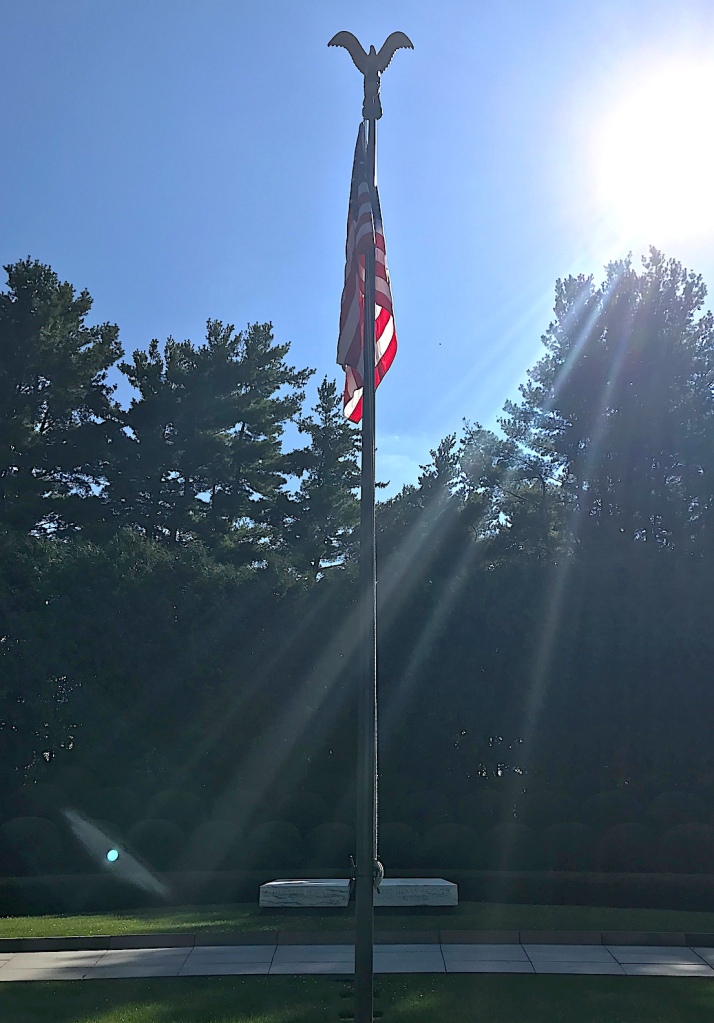
It would be easy to sink into the debate over how much Herbert Hoover was out of touch and inept as a president, as many scholars opine. But as we were heading back to our car, I thought how more interested I was in the Hoover marriage. They were both outdoor enthusiasts, highly intelligent, shared a love of geology, and were devoted to each other. I don’t doubt that they had some lively debates in their private moments. More than some presidential marriages, I think the Hoovers respected and loved each other deeply.
It was time to head to Iowa City to check into our hotel for the night. We had another Iowa cemetery stop before we returned to Nebraska.


